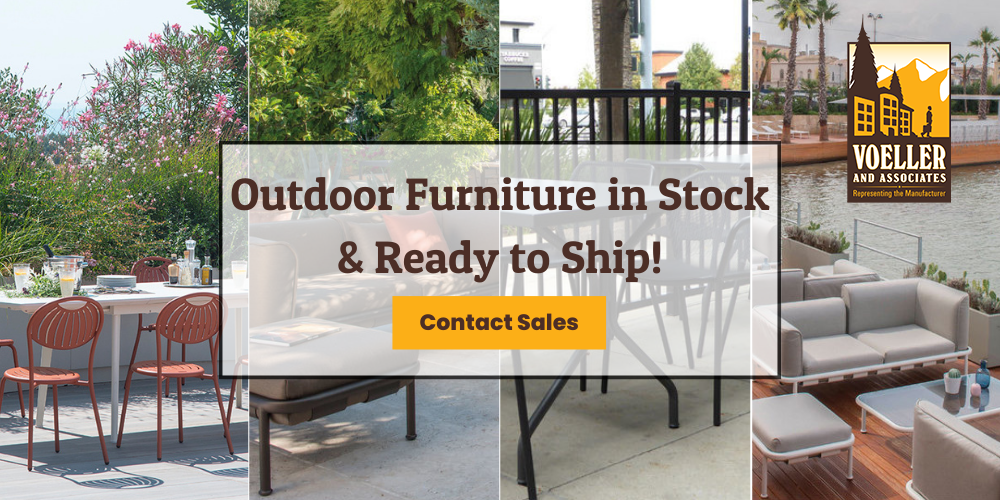It’s been a few years since the expansion of outdoor dining became necessary for restaurants and hotels to remain in operation during the Covid. Creating table seating outside was the only course of action during the pandemic, and many businesses took full advantage of the opportunity.
During that time, the usual crowds of hungry customers and frequent vacationers dwindled. Families who decided to leave their homes were highly selective about where their time and money were spent. Priority was often given to hospitality and foodservice businesses based on outdoor dining and square footage.
Flash forward to today, and the demand for outdoor dining hasn’t lessened or remained stagnant. The National Restaurant Association reports that outdoor seating can increase sales by up to 30 percent, which translates to guaranteed revenue for hotels, resorts, and restaurants. Providing comfortable and attractive outdoor dining furniture improves the customer experience and delights guests looking for a much-needed escape from reality. However, to create a welcoming outdoor space for people who like to linger over premium-priced cuisine, it’s essential to carefully select the type of material used to make each piece of furniture.
Durability, style, and ease of maintenance are just a few things to consider when selecting furnishings for outdoor eating experiences. Some materials recommended for outdoor furniture include aluminum, wood, metal, resin, synthetic wicker, and high-quality plastic solutions. Each material has its benefits, such as resistance to weather, rust, and fading, and the ability to create a range of styles, from classic to modern.
Let’s take a brief look at the pros and cons of materials commonly used in outdoor furniture designs.
Metal
Selecting metal for outdoor seating has several Thor-like advantages. Metal is strong and durable. It can withstand harsh weather, so it’s ideal for outdoor seating. It also requires minimal maintenance, is fire-resistant, and can be easily cleaned. Available in various styles, finishes, and colors, it’s easy to match metal designs to any aesthetic. Even better, there are lightweight metal tables and chairs that are easy to move around and highly efficient for venues looking to accommodate a variety of different-sized events throughout the year.
When considering metal furniture, it’s important to know that it can get hot when exposed to direct sunlight, especially during summer. Some types of metal tend to heat up less than others. But there are ways to prevent hot metal furniture from becoming a pain. Incorporate perforations or mesh patterns in the metal furniture design to allow air to circulate, prevent overheating, and offer cushions or fabric covers to reduce heat transfer.
Wood
Choosing wood as part of an outdoor dining experience is like selecting a luxury vacation destination. The beauty and durability of wood can be breathtaking, like a pristine beach at sunset. Even better, when the wood looks worn, it can be refinished to keep its beautiful appearance.
However, just like a luxurious vacation, wood furniture can come with a high price tag. And, if not properly maintained, wooden tables and chairs begin to rot. Therefore, regular maintenance may be needed to keep looking high-end. Despite these potential drawbacks, wood furniture's timeless beauty and durability make it a popular choice for hotels, fine-dining restaurants, and resorts looking to make lasting impressions.
Plastic
When it comes to outdoor dining furniture for many highly trafficked resorts and hotels, plastic is a popular choice due to its affordability, lightweight design, and ease of cleaning. In addition, plastic furniture is often available at a lower price point than other materials, making it a budget-friendly option for those looking to furnish their outdoor spaces. Its lightweight design also makes it easy to move around, which can be beneficial for events or rearranging outdoor areas.
Keep in mind that plastic furniture may not withstand as much use, weather, or weight as metal or wood and can be susceptible to fading and staining when exposed to the elements. Yet, despite drawbacks, plastic furniture remains a proven choice for outdoor spaces due to its affordability and ease of maintenance.
Aluminum
Aluminum outdoor furniture is always of sturdy construction and well-built for dining areas that welcome a lot of heavy foot traffic. Its lightweight design and durable quality make it ideal for restaurants, country clubs, and beach hotels, with profits that depend on accommodating customers in all types of weather. Plus, the low-maintenance nature of aluminum makes upkeep feel easier than enjoying a five-course meal without having to clean up afterward.
However, just like a fine dining experience, the cost of aluminum furniture can be high. And it's one of those metals that can get hot in the sun and is susceptible to dents in eating areas that experience repeat use 24 hours a day. Even with these few sticking points, aluminum furniture's durability and aesthetic appeal make it a popular choice for beachside dining and areas near swimming pools.
Learn more about in-stock outdoor furniture and connect with our sales team for a new (functional) look today!
.png)
